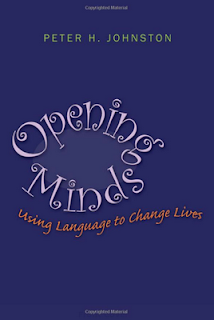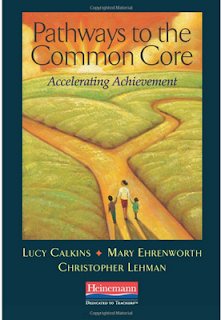MATH EXCHANGES is written about young children. The examples are from K-3 classrooms and the focus is really on very young (K-1) children. But the implications for all teachers is huge. Kassia's understanding of not only mathematics, but of how children develop, how she looks at student work, the strategic ways in which she builds problems and scaffolds for children, taught me a great deal.
One thing I love about Kassia's message is her message of "joyful rigor". She says, "Community, rigor, and joy are at the heart of the workshop approach to teaching and learning." She connects much of her workshop to what she has learned from Peter Johnston in Choice Words as she talks about the importance of identity and agency in mathematics.
Kassia is honest in admitting that math workshop is hard work. She says, "Math workshop is not the easiest path to take. We have plenty of outside resources willing to tell us exactly what, when and how to teach our students. And yet, none of these resources has the intimate knowledge of our community of mathematicians that you have. Math workshop communities create empowered learners-both students and teachers-who question, wonder, explore and make conjectures. Rigorous joy in math is within the realm of the possible-it is, in fact, what makes math workshop worth it!"
Kassia shares her knowledge about math, types of problems, intentional planning and how she learns about a child's understanding. Kassia includes story after story to help us see what this looks and sounds like in a real classroom. The student samples help us begin to see the ways that she learns from student work. And she includes tools and forms that will help us as we try to implement some of her ideas.
Some of my favorite lines from this book include:
We will work to become experts on the development of each of our young mathematicians.
Regardless of the math program or curriculum you are using, working to understand each individual child's math development and how to responsively guide children to deeper understanding through small-group work remains the strongest way in which we, as teachers, can promote a strong mathematical foundation for our learners. p. 22
Math exchanges emphasize change. This may sound simple, but the purpose of meeting with small groups of mathematicians is to produce change and growth in their thinking....Math exchanges put the focus on planned, purposeful exchanges between mathematicians of different abilities. . 33
In Teaching Essentials, Regie Routman writes about "teaching with a sense of urgency". Before reading her words, I had always associated urgency with a feeling of anxiety. However, after reading and thinking further I found that "the expectation that there is not a minute to lose, that every moment must be used for purposeful instruction" rings true not just within the context of teaching literacy, which Routman writes about, but throughout the entire day as teachers. p. 36
Purposeful and effective planning does not begin by focusing on what a student does not know. p.63
Problem solving, with carefully chosen problem types and numbers, is one of the best ways to help children build strong understandings of the number system. p. 137
I strive to achieve balance between two kinds of reflections during math workshop: content reflection....and process reflection. Content reflection focuses on a specific math concept or strategy that you and your class have been discussing and working on...Process reflection on the other hand, focuses on developing practices and behaviors of strong mathematicians. p. 177
I cannot possibly include all that I loved about this book. I cannot possibly share all that I learned or all that I came away thinking with. What I do know is that this book will impact my teaching of math to better match what I believe about students and learning.
Kassia is honest in admitting that math workshop is hard work. She says, "Math workshop is not the easiest path to take. We have plenty of outside resources willing to tell us exactly what, when and how to teach our students. And yet, none of these resources has the intimate knowledge of our community of mathematicians that you have. Math workshop communities create empowered learners-both students and teachers-who question, wonder, explore and make conjectures. Rigorous joy in math is within the realm of the possible-it is, in fact, what makes math workshop worth it!"
Kassia shares her knowledge about math, types of problems, intentional planning and how she learns about a child's understanding. Kassia includes story after story to help us see what this looks and sounds like in a real classroom. The student samples help us begin to see the ways that she learns from student work. And she includes tools and forms that will help us as we try to implement some of her ideas.
Some of my favorite lines from this book include:
We will work to become experts on the development of each of our young mathematicians.
Regardless of the math program or curriculum you are using, working to understand each individual child's math development and how to responsively guide children to deeper understanding through small-group work remains the strongest way in which we, as teachers, can promote a strong mathematical foundation for our learners. p. 22
Math exchanges emphasize change. This may sound simple, but the purpose of meeting with small groups of mathematicians is to produce change and growth in their thinking....Math exchanges put the focus on planned, purposeful exchanges between mathematicians of different abilities. . 33
In Teaching Essentials, Regie Routman writes about "teaching with a sense of urgency". Before reading her words, I had always associated urgency with a feeling of anxiety. However, after reading and thinking further I found that "the expectation that there is not a minute to lose, that every moment must be used for purposeful instruction" rings true not just within the context of teaching literacy, which Routman writes about, but throughout the entire day as teachers. p. 36
Purposeful and effective planning does not begin by focusing on what a student does not know. p.63
Problem solving, with carefully chosen problem types and numbers, is one of the best ways to help children build strong understandings of the number system. p. 137
I strive to achieve balance between two kinds of reflections during math workshop: content reflection....and process reflection. Content reflection focuses on a specific math concept or strategy that you and your class have been discussing and working on...Process reflection on the other hand, focuses on developing practices and behaviors of strong mathematicians. p. 177
I cannot possibly include all that I loved about this book. I cannot possibly share all that I learned or all that I came away thinking with. What I do know is that this book will impact my teaching of math to better match what I believe about students and learning.
(If you are interested in hearing more from Kassia about math teaching, you can access her Choice Literacy podcast here.)























